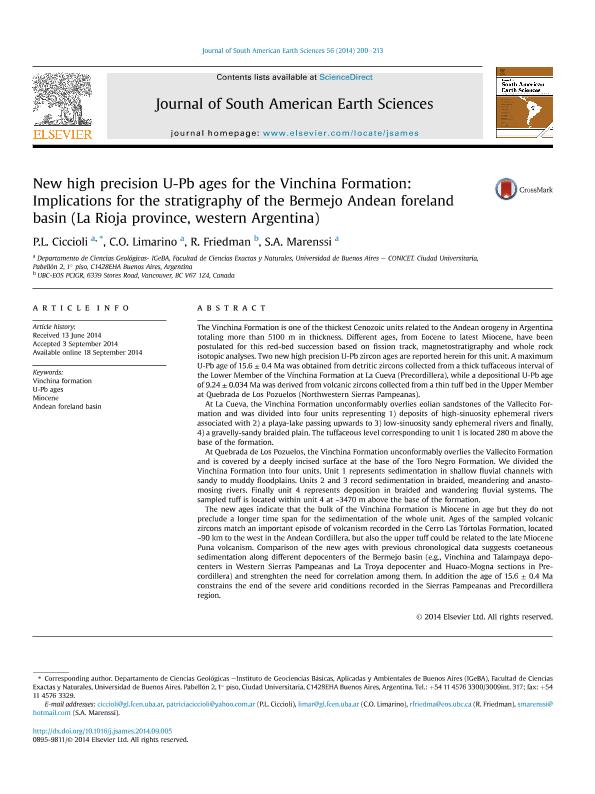Artículo
New high precision U-Pb ages for the Vinchina Formation: implications for the stratigraphy of the Bermejo Andean foreland basin (La Rioja province, western Argentina)
Fecha de publicación:
09/2014
Editorial:
Elsevier
Revista:
Journal of South American Earth Sciences
ISSN:
0895-9811
Idioma:
Inglés
Tipo de recurso:
Artículo publicado
Clasificación temática:
Resumen
The Vinchina Formation is one of the thickest Cenozoic units related to the Andean orogeny in Argentina totaling more than 5100 m in thickness. Different ages, from Eocene to latest Miocene, have been postulated for this red-bed succession based on fission track, magnetostratigraphy and whole rock isotopic analyses. Two new high precision U-Pb zircon ages are reported herein for this unit. A maximum U-Pb age of 15.6 ± 0.4 Ma was obtained from detritic zircons collected from a thick tuffaceous interval of the Lower Member of the Vinchina Formation at La Cueva (Precordillera), while a depositional U-Pb age of 9.24 ± 0.034 Ma was derived from volcanic zircons collected from a thin tuff bed in the Upper Member at Quebrada de Los Pozuelos (Northwestern Sierras Pampeanas). At La Cueva, the Vinchina Formation unconformably overlies eolian sandstones of the Vallecito Formation and was divided into four units representing 1) deposits of high-sinuosity ephemeral rivers associated with 2) a playa-lake passing upwards to 3) low-sinuosity sandy ephemeral rivers and finally, 4) a gravelly-sandy braided plain. The tuffaceous level corresponding to unit 1 is located 280 m above the base of the formation. At Quebrada de Los Pozuelos, the Vinchina Formation unconformably overlies the Vallecito Formation and is covered by a deeply incised surface at the base of the Toro Negro Formation. We divided the Vinchina Formation into four units. Unit 1 represents sedimentation in shallow fluvial channels with sandy to muddy floodplains. Units 2 and 3 record sedimentation in braided, meandering and anastomosing rivers. Finally unit 4 represents deposition in braided and wandering fluvial systems. The sampled tuff is located within unit 4 at ~3470 m above the base of the formation. The new ages indicate that the bulk of the Vinchina Formation is Miocene in age but they do not preclude a longer time span for the sedimentation of the whole unit. Ages of the sampled volcanic zircons match an important episode of volcanism recorded in the Cerro Las Tortolas Formation, located ~90 km to the west in the Andean Cordillera, but also the upper tuff could be related to the late Miocene Puna volcanism. Comparison of the new ages with previous chronological data suggests coetaneous sedimentation along different depocenters of the Bermejo basin (e.g., Vinchina and Talampaya depocenters in Western Sierras Pampeanas and La Troya depocenter and Huaco-Mogna sections in Precordillera) and strenghten the need for correlation among them. In addition the age of 15.6 ± 0.4 Ma constrains the end of the severe arid conditions recorded in the Sierras Pampeanas and Precordillera region.
Palabras clave:
Vinchina Formation
,
U-Pb Ages
,
Miocene
,
Foreland Basin
Archivos asociados
Licencia
Identificadores
Colecciones
Articulos(IGEBA)
Articulos de INSTITUTO DE GEOCIENCIAS BASICAS, APLICADAS Y AMBIENTALES DE BS. AS
Articulos de INSTITUTO DE GEOCIENCIAS BASICAS, APLICADAS Y AMBIENTALES DE BS. AS
Citación
Ciccioli, Patricia Lucia; Limarino, Carlos Oscar; Friedman, R.; Marenssi, Sergio Alfredo; New high precision U-Pb ages for the Vinchina Formation: implications for the stratigraphy of the Bermejo Andean foreland basin (La Rioja province, western Argentina); Elsevier; Journal of South American Earth Sciences; 56; 9-2014; 200-213
Compartir
Altmétricas




